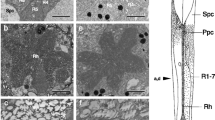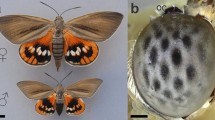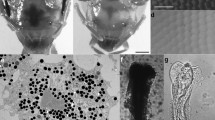Summary
The spectral sensitivity of dark adapted eyes of the moth Manduca sexta (Lepidoptera: Sphingidae) was measured between 350 and 650 nm by determining the relative number of photons necessary to elicit a retinal potential of 50 μV. The spectral sensitivity was determined in eyes with the screening pigment: a) in the extreme distal position, b) in a proximal position, and c) with the pigment removed. Sensitivity maxima were found at about 350 to 370, 450 and 530 nm, irrespective of pigment position.
Pigment movement is associated with a change in light attenuation of 2 to 3 log units at all wavelengths between 350 and 650 nm. Only small variations, about 0.6 log units, in screening effect were observed throughout the measured spectrum, and therefore the effect of pigment movement on spectral sensitivity is small.
There is a slightly larger decline in sensitivity of eyes with the pigment removed compared to eyes with the pigment in the distal position at wavelengths above 530 nm. This result suggests that the distally located pigments have a slight screening effect.
Similar content being viewed by others
References
Autrum, H.: Die spektrale Empfindlichkeit der Augenmutation white-apricot von Calliphora erythrocephala. Biol. Zbl. 74, 515–524 (1955).
Bäck, I., Donner, K. O., Reuter, T.: The screening effect of the pigment epithelium on the retinal rods in the frog. Vision Res. 5, 101–111 (1965).
Bernhard, C. G., Miller, W. H., Møller, A. R.: The insect corneal nipple array. Acta physiol. scand. 63, Suppl. 243 (1965).
—, Ottoson, D.: Studies on the relation between the pigment migration and the sensitivity changes during dark adaptation in diurnal and nocturnal Lepidoptera. J. gen. Physiol. 44, 205–215 (1960).
Boëthius, J., Carlson, S. D., Höglund, G., Struwe, G.: Spectral efficiency of single photoreceptor cells of the moth (Manduca sexta). Acta physiol. scand. 74, 36A-37A (1968).
Bruckmoser, P.: Die spektrale Empfindlichkeit einzelner Sehzellen des Rückenschwimmers Notonecta glauca L., (Heteroptera). Z. vergl. Physiol. 59, 187–204 (1968).
Burkhardt, D.: Colour discrimination in insects. Adv. Insect Physiol. 2, 131–173 (1964).
Butenandt, A., Biekert, E., Kübler, H., Linzen, B.: Über Ommochrome: XX. Zur Verbreitung der Ommatine im Tierreich. Hoppe-Seylers Z. physiol. Chem. 319, 238–256 (1960).
—, Linzen, B.: Über Ommochrorne: XIV. Zur Verbreitung der Ommine im Tierreich. Hoppe-Seylers Z. physiol. Chem. 313, 251–258 (1958).
Ephrussi, B., Beadle, G. W.: A technique of transplantation for Drosophila. Amer. Nat. 70, 218–225 (1936).
Goldsmith, T. H.: Do flies have a red receptor? J. gen. Physiol. 49, 265–287 (1965).
Höglund, G.: Pigment migration, light screening and receptor sensitivity in the compound eye of nocturnal Lepidoptera. Acta physiol. scand. 69, Suppl. 282 (1966).
—, Langer, H., Struwe, G., Thorell, B.: Spectral absorption by screening pigment granules in the compound eyes of a moth and a wasp. Z. vergl. Physiol. 67, 238–242 (1970).
Kuiper, J. W.: The optics of the compound eye. Symp. Soc. exp. Biol. 16, 58–71 (1962).
Langer, H.: Über die Pigmentgranula im Facettenauge von Calliphora erythrocephala. Z. vergl. Physiol. 55, 354–377 (1967).
—, Hoffmann, C.: Elektro- und Stoffwechselphysiologische Untersuchungen über den Einfluß von Ommoohromen und Pteridinen auf die Funktion des Facettenauges von Calliphora erythrocephala. J. Insect Physiol. 12, 357–387 (1966).
Linzen, B.: Zur Biochemie der Ommochrome. Naturwissenschaften 54, 259–267 (1967).
Lüdtke, H.: Retinomotorik und Adaptationsvorgänge im Auge des Rückenschwimmers (Notonecta glauca L.) Z. vergl. Physiol. 35, 129–152 (1953).
—: Dunkeladaptation und Verschiebung der Helligkeitswerte im Auge von Notonecta glauca L. Z. Naturforsch. 9b, 159–163 (1954).
Machan, L.: Spectral sensitivity of scorpion eyes and the possible role of shielding pigment effect. J. exp. Biol. 49, 95–105 (1968).
Post, C. T., Jr., Goldsmith, T. H.: Pigment migration and light-adaptation in the eye of the moth, Galleria mellonella. Biol. Bull. 128, 473–487 (1965).
Strother, G. K.: Absorption of Musca domestica screening pigment. J. gen. Physiol. 49, 1087–1088 (1966).
Author information
Authors and Affiliations
Additional information
We are grateful to Dr. Bo Lindström for advice regarding the statistical treatment of the experimental data.
This work was supported partly by the Swedish Medical Research Council, Stifteisen Gustaf och Tyra Svenssons Minne, Reservationsanslaget,and partly by the Air Force Office of Scientific Research through the European Office of Aerospace Research, OAR, United States Air Force under grant number EOOAR-68-0036.
Rights and permissions
About this article
Cite this article
Höglund, G., Struwe, G. Pigment migration and spectral sensitivity in the compound eye of moths. Z. vergl. Physiologie 67, 229–237 (1970). https://doi.org/10.1007/BF00340950
Received:
Issue Date:
DOI: https://doi.org/10.1007/BF00340950




